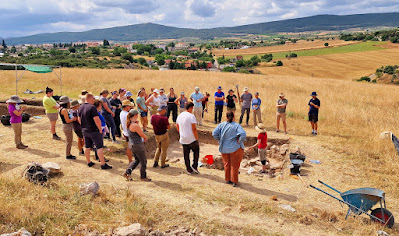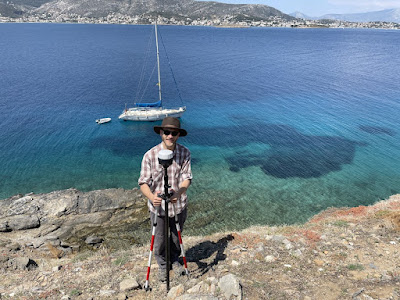Team members arriving at sunrise, June 2023
A new phase for the Eastern Boeotia Archaeological Project (EBAP)
began this summer when excavations at ancient Eleon resumed after five years of
study and survey. Our project started as a regional survey from 2007-2009,
followed by an initial campaign of excavations from 2012-2018. This year, our
project ran for six weeks, from May 21 to June 30, 2023. We went from
spring-like weather, verdant and rainy, to the peak of Greek summer, dry and
hot. Our team was large, reaching 42 undergraduates, graduate students,
post-doctoral researchers, and other professionals. As always, we were based at
the seaside community of Dilesi and made our daily commute to the town of Arma,
located midway between Schimatari and Thebes. This was our 15th full season of
research in eastern Boeotia, and we continue to be enormously grateful to our
colleagues at the Thebes Museum and in the Ephorate of Antiquities of Boeotia,
and to the Canadian Institute in Greece.
Our long-time collaborator, Professor Nicholas Herrmann from Texas State University, with a small team, conducted geomagnetometry and resistivity survey in 2021 and 2022. At the same time, Trevor Van Damme led a group focused on the finds from 2007-2009 survey. The results from both projects revealed that the Archaic and Classical settlement of ancient Eleon was considerably larger than previously known and that there was a lower town extending to the north and west of the acropolis. With these results, we applied for and received approval to renew our excavation work in hopes of learning more about the historical phases of occupation that have been so far underrepresented on the acropolis.
Before and after site cleaning
Before we could start digging, however, two things had to happen: our
site needed to be cleared of overgrowth from the wet spring and we needed to
upgrade our record keeping system. Clearing the site was challenging but fairly
straightforward, and our team of workers was excellent. Within days a lush
meadow of waist-high green grass punctuated by cheerful red poppies was
immaculately mowed and the tarps protecting the trenches from winter rains were
lifted.
iDig training. From L-R: Krysten Cruz, Nicholas Herrmann, Bruce Hartzler, Bryan Burns, Brendan Burke, photo by Georgios Verigakis
While the site was being prepared for the new season of excavations, our senior staff were hard at work upgrading our recording system. After over a decade of keeping traditional records on paper, we decided to transition to fully digital recording in the field. This is accomplished using an open-source digital application, iDig, which has been widely adopted by other projects across the Mediterranean region.
iDig is an archaeological record keeping system originally developed
by Bruce Hartzler for the Athenian Agora excavations. Bruce, Brian Martens, and
Georgios Verigakis, also from the Athenian Agora, collaborated with us during
the first week of the project to tailor fit our Eleon recording system to iDig.
It was a big adjustment, but the convenience, standardization, and efficiency
of iDig is a vast improvement. We are extremely grateful to Bruce, Brian, and
Georgios for their patience, technical expertise, and generous support. Each of
our five trench supervisors received an iPad loaded with iDig and all the
excavation data (photographs, descriptions, find records, drawings, survey
information) was recorded on it. Each iPad was synced daily through a server
computer, so that every iPad had a current record of all the trenches. The
conservators and ceramic processors also had their own iPads where they entered
information relevant to each trench allowing data to be shared in real time
between all team members. It’s an excellent system!
EBAP Team photo June 2023
Our team of field workers was made up of undergraduate students from Brown University, Skidmore College, the University of Victoria, and Wellesley College: Katharine Barrett, Camille Blanco, Skyler Buchfink, Maya Christensen, Ruth Engelman, Hunter Faminow, Megan Farrokhi, Max Harris, Riley Kernohan, Sally Martin-Damman, Elysia Nitsch, Minah Park, Kallie Schildge, Sophie Shobeiri, Kristen Smit, plus graduate students Audrey Ballarin (not pictured), Kaitlyn McKenna, Luke Montgomery, Lori Zhang. Our trench supervisors were graduate students Haley Bertram, University of Cincinnati; Antigone Paschaki, University of Athens; Hana Sugioka, University of Texas at Austin; Ben Watts-Wooldridge, University of Victoria; Savhanna Long, University of Arizona. Senior staff and researchers included Jeremy Beller (not pictured), Joe Bellows, Annika Berendt, Giuliana Bianco (not pictured), Brendan Burke, Bryan Burns, Krysten Cruz, Allie Davis, Adam DiBattista (not pictured), Scott Evans, Amanda Gaggioli, Nick Herrmann, Vicky Karas, Tina Ross, Janelle Sadarananda, Nepheli Theocharou, Trevor Van Damme, Zoe Wieler. Our success is due to the tireless efforts, keen observations, and good cheer every day of the entire team.
Trench tours, ancient Eleon June 17, 2023
For the excavations, we wanted to explore areas to the west and south
of our previous trenches, so several new units were opened. Contrary to our
initial expectations, in every new trench we opened in 2023, we found
significant stratified levels dating to the Mycenaean period just below surface
levels. Our work in 2023 demonstrated that the acropolis of Eleon was an
exceptionally large settlement throughout most of the Late Bronze Age
(1700-1100 BCE) and revealed an important LH IIIA1 deposit, a phase that was
previously underrepresented due to the density of LH IIIC architecture on the
acropolis. In another trench, a well-preserved floor deposit was documented
dating to early in the 12th century BCE, including a complete Mycenaean roof
tile (photo below).
Excavating Mycenaean roof tile, ancient Eleon
As we have in other years previously, we wanted to share our work with our community in Arma and the Tanagraia area. We were very happy to work with the Σύλλογος Γυναικών Άρματος and Eugenia Triantafillou to host an ‘Open House’ for interested community members on June 24, 2023. We welcomed over 50 community members, young and old, to the site to see and hear what we have been finding and to view some of the recently restored finds up close. We look forward to sharing our work again in 2024!
Open House’ with the Σύλλογος Γυναικών Άρματος on June 24, 2023
We look forward to continuing our work in 2024, when we plan to test new areas of the settlement in hopes of learning more about the Archaic and Classical settlement!
Brendan Burke, Bryan Burns & Trevor Van Damme, EBAP




















